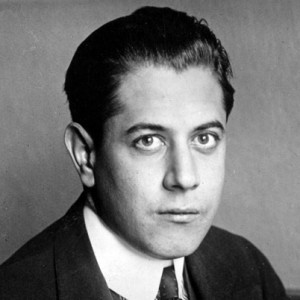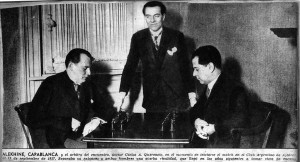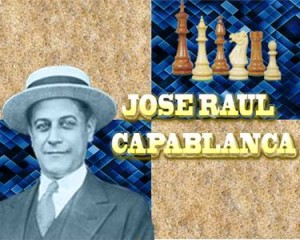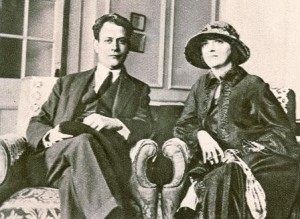JOSÉ RAÚL CAPABLANCA, WORLD CHESS CHAMPION.
 José Raúl Capablanca y Graupera (19 November 1888 – 8 March 1942) was a Cuban chess player who was world chess champion from 1921 to 1927. One of the greatest players of all time, he was renowned for his exceptional endgame skill and speed of play. Due to his achievements in the chess world, mastery over the board and his relatively simple style of play he was nicknamed the “Human Chess Machine”.
José Raúl Capablanca y Graupera (19 November 1888 – 8 March 1942) was a Cuban chess player who was world chess champion from 1921 to 1927. One of the greatest players of all time, he was renowned for his exceptional endgame skill and speed of play. Due to his achievements in the chess world, mastery over the board and his relatively simple style of play he was nicknamed the “Human Chess Machine”.
Capablanca became the World Chess Champion in 1921 by beating Emanuel Lasker. He lost the title in 1927 to Alexander Alekhine.
José Raúl Capablanca, the second surviving son of a Spanish army officer, was born in Havana on November 19, 1888. According to Capablanca, he learned the rules of the game at the age of four by watching his father play, pointed out an illegal move by his father, and then beat his father twice. At the age of eight he was taken to Havana Chess Club, which had hosted many important contests, but on the advice of a doctor he was not allowed to play frequently. Between November and December 1901, he narrowly beat the Cuban Chess Champion, Juan Corzo, in a match.
In 1905 Capablanca passed the entrance examinations with ease for Columbia University in New York City, where he wished to play for Columbia’s strong baseball team, and soon was selected as shortstop on the freshman team. In the same year he joined the Manhattan Chess Club, and was soon recognized as the club’s strongest player. He was particularly dominant in rapid chess, winning a tournament ahead of the reigning World Chess Champion, Emanuel Lasker, in 1906. In 1908 he left the university to concentrate on chess.
Early adult career.
Capablanca’s skill in rapid chess lent itself to simultaneous exhibitions, and his increasing reputation in these events led to a USA-wide tour in 1909. Playing 602 games in 27 cities, he scored 96.4% – a much higher percentage than those of, for example, Géza Maróczy’s 88% and Frank Marshall’s 86% in 1906. This performance gained him sponsorship for an exhibition match that year against Marshall, the US champion, who had won the 1904 Cambridge Springs tournament ahead of World Champion Emanuel Lasker and Dawid Janowski, and whom Chessmetrics ranks as one of the world’s top three players at his peak. Capablanca beat Marshall by 15–8 (8 wins, 1 loss, 14 draws) – a margin comparable to what Emanuel Lasker achieved against Marshall (8 wins, no losses, 7 draws) in winning his 1907 World Championship match. After the match, Capablanca said that he had never opened a book on chess openings. Following this match, Chessmetrics rates Capablanca the world’s third strongest player for most of the period from 1909 through 1912.
During World War I.
World War I began in midsummer 1914, bringing international chess to a virtual halt for more than four years. Capablanca won tournaments in New York in 1914, 1915, 1916 (with preliminary and final round-robin stages) and 1918, losing only one game in this sequence. In the 1918 event Marshall, playing Black against Capablanca, unleashed a complicated counter-attack, later known as the Marshall Attack, against the Ruy Lopez opening. It is often said that Marshall had kept this secret for use against Capablanca since his defeat in their 1909 match; however, Edward Winter discovered several games between 1910 and 1918 where Marshall passed up opportunities to use the Marshall Attack against Capablanca; and an 1893 game that used a similar line. This gambit is so complex that Garry Kasparov used to avoid it, and Marshall had the advantage of using a prepared variation. Nevertheless, Capablanca found a way through the complications and won.
World Champion.
The Hastings Victory tournament of 1919 was the first international competition on Allied soil since 1914. The field was not strong, and Capablanca won with 10½ points out of 11, one point ahead of Kostić.
In January 1920, Emanuel Lasker and Capablanca signed an agreement to play a World Championship match in 1921, noting that Capablanca was not free to play in 1920. Because of the delay, Lasker insisted that if he resigned the title, then Capablanca should become World Champion. Lasker had previously included in his agreement before World War I to play Akiba Rubinstein for the title a similar clause that if he resigned the title, it should become Rubinstein’s. Lasker then resigned the title to Capablanca on June 27, 1920, saying, “You have earned the title not by the formality of a challenge, but by your brilliant mastery.” When Cuban enthusiasts raised $20,000 to fund the match provided it was played in Havana, Lasker agreed in August 1920 to play there, but insisted that he was the challenger as Capablanca was now the champion. Capablanca signed an agreement that accepted this point, and soon afterwards published a letter confirming it.
The match was played in March–April 1921; Lasker resigned it after fourteen games, having lost four games and won none. Reuben Fine and Harry Golombek attributed the one-sided result to Lasker’s being in mysteriously poor form. Fred Reinfeld mentioned speculations that Havana’s humid climate weakened Lasker and that he was depressed about the outcome of World War I, especially as he had lost his life savings. On the other hand, Vladimir Kramnik thought that Lasker played quite well and the match was an “even and fascinating fight” until Lasker blundered in the last game. Kramnik explained that Capablanca was twenty years younger, a slightly stronger player, and had more recent competitive practice.
In 1922, Capablanca also gave a simultaneous exhibition in Cleveland against 103 opponents, the largest in history up to that time, winning 102 and drawing one – setting a record for the best winning percentage ever in a large simultaneous exhibition.
After beginning with four draws, followed by a loss, Capablanca placed second at the New York 1924 chess tournament with the score of 14/20 (+10 −1 =9), 1½ points behind Emanuel Lasker, and 2 ahead of third-placed Alekhine.
Capablanca’s defeat at the hands of Richard Réti in the fifth round was his first in serious competition in eight years. He made another bad start at the Moscow 1925 chess tournament, and could only fight back to third place, two points behind Bogoljubow and ½ point behind Emanuel Lasker. Capablanca won at Lake Hopatcong, 1926 with 6 points out of 8, ahead of Abraham Kupchik (5) and Maroczy (4½).
A group of Argentinian businessmen, backed by a guarantee from the president of Argentina, promised the funds for a World Championship match between Capablanca and Alekhine in 1927. Since Nimzowitsch had challenged before Alekhine, Capablanca gave Nimzowitsch until January 1, 1927 to deposit a forfeit in order to arrange a match. When this did not materialize, a Capablanca–Alekhine match was agreed, to begin in September 1927.
In December 1921, shortly after becoming World Champion, Capablanca married Gloria Simoni Betancourt. They had a son, José Raúl Jr., in 1923 and a daughter, Gloria, in 1925. According to Capablanca’s second wife, Olga, his first marriage broke down fairly soon, and he and Gloria had affairs. Both his parents died during his reign, his father in 1923 and mother in 1926.
Losing the title.
Since Capablanca had won the New York 1927 chess tournament overwhelmingly and had never lost a game to Alekhine, the Cuban was regarded by most pundits as the clear favorite in their World Chess Championship 1927 match. However, Alekhine won the match, played from September to November 1927 at Buenos Aires, by 6 wins, 3 losses, and 25 draws – the longest formal World Championship match until the contest in 1984–85 between Anatoly Karpov and Garry Kasparov. Alekhine’s victory surprised almost the entire chess world. After Capablanca’s death, Alekhine expressed surprise at his own victory, since in 1927 he had not thought he was superior to Capablanca, and he suggested that Capablanca had been overconfident.
Immediately after winning the match, Alekhine announced that he was willing to give Capablanca a return match, on the same terms that Capablanca had required as champion – the challenger must provide a stake of US $10,000, of which more than half would go to the defending champion even if he was defeated. Alekhine had challenged Capablanca in the early 1920s but Alekhine could not raise the money until 1927. After Capablanca’s death, Alekhine wrote that Capablanca’s demand for a $10,000 stake was an attempt to avoid challenges. Negotiations dragged on for several years, often breaking down when agreement seemed in sight. Their relationship became bitter, and Alekhine demanded much higher appearance fees for tournaments in which Capablanca also played.
It is from this period that the only surviving voiced film footage survives. He is with Max Euwe and Dutch radio sports journalist Han Hollander. Hollander asks Capablanca for his views on the upcoming world Championship match between Euwe and Alekhine in October of that year (1935). Capablanca replies: “Dr. Alekhine’s game is 20% bluff. Dr. Euwe’s game is clear and straightforward. Dr. Euwe’s game—not so strong as Alekhine’s in some respects—is more evenly balanced.” Then Euwe gives his assessment in Dutch, explaining that his feelings alternated from optimism to pessimism, but in the previous ten years, their score had been evenly matched at 7–7.
Return to competitive chess.
At first Capablanca did not divorce his first wife, as he had not intended to remarry. Olga, Capablanca’s second wife, wrote that she met him in the late spring of 1934; by late October the pair were deeply in love, and Capablanca recovered his ambition to prove he was the world’s best player. In 1938 he divorced his first wife and then married Olga on October 20, 1938, about a month before the AVRO tournament.
Starting his comeback at the Hastings tournament of 1934–35, Capablanca finished fourth, although coming ahead of Mikhail Botvinnik and Andor Lilienthal. He placed second by ½ point in the Margate tournaments of 1935 and 1936. At Moscow 1935 Capablanca finished fourth, 1 point behind the joint winners, while Emanuel Lasker’s third place at the age of 66 was hailed as “a biological miracle.”
During these triumphs Capablanca began to suffer symptoms of high blood pressure. He tied for second place at Semmering in 1937, then could only finish seventh of the eight players at the 1938 AVRO tournament, an élite contest designed to select a challenger for Alekhine’s world title. Capablanca’s high blood pressure was not correctly diagnosed and treated until after the AVRO tournament, and caused him to lose his train of thought towards the end of playing sessions. In 1940, Capablanca was found to have extremely dangerous hypertension of 210 systolic/180 diastolic (hypertensive crisis is 180/120 or above, and even after treatment Capablanca had 180/130).
After winning at Paris in 1938 and placing second in a slightly stronger tournament at Margate in 1939, Capablanca played for Cuba in the 8th Chess Olympiad, held in Buenos Aires, and won the gold medal for the best performance on the top board. While Capablanca and Alekhine were both representing their countries in Buenos Aires, Capablanca made a final attempt to arrange a World Championship match. Alekhine declined, saying he was obliged to be available to defend his adopted homeland, France, as World War II had just broken out.
Death.
On 7 March 1942, Capablanca was observing a skittles game and chatting with friends at the Manhattan Chess Club in New York City, when he asked for help removing his coat, and collapsed shortly afterward. He was taken to Mount Sinai Hospital, where he died at 6 a.m. the next morning. The cause of death was given as “a cerebral hemorrhage provoked by hypertension”. Not long before his death, his familial hypertension had shot up to the ultra-hazardous 200–240/160+. His doctor strongly advised him that his life was endangered unless he totally relaxed, but Capablanca said that he couldn’t because his ex-wife and children had started court proceedings against him. The doctor blamed Capa’s death on “his troubles and aggravation.” Capablanca’s great rival Emanuel Lasker had died in the same hospital only a year earlier.
Capablanca was given a public funeral in Havana’s Colón Cemetery on March 15, 1942.
An annual Capablanca Memorial tournament has been held in Cuba, most often in Havana, since 1962.
Agencies/Various/Wiki/InternetPhotos/www.thecubanhistory.com
The Cuban History, Hollywood.
Arnoldo Varona, Editor.



 JOSÉ RAÚL CAPABLANCA, World Chess Champion. (Born: Havana) *** José Raúl Capablanca, Campeón Mundial de Ajedrez.(Nacido en La Habana)
JOSÉ RAÚL CAPABLANCA, World Chess Champion. (Born: Havana) *** José Raúl Capablanca, Campeón Mundial de Ajedrez.(Nacido en La Habana)





